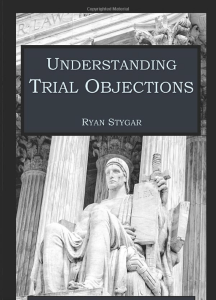Understanding Trial Objections
By Ryan Styger
Date of Publication: 2019
181 Pages
4.1/5☆

What This Book is About
In “Understanding Trial Objections” by Ryan Stygar, the reader is taught how to raise and overcome trial objections. This book is in essence a ‘How-To’ book, by giving the reader the ingredients they need to fullyunderstandtrial objections, and then, how to use them to their advantage. The book is broken up into five parts, Part IV being the most important and useful section. It’s where the main focus is and what readers should pay the most attention to.
What I Liked About This Book
The best part of this book is how it is broken down into smaller sections. Within Part IV there are 31 topics. Now that sounds like a lot, but each topic is only 3-5 pages long, making each topic short and to the point. Each of those 31 topics covers a different objection. Within those topics there are subtopics: basis, what to look for, examples, remedy and response. These breakdowns make the book really easy to use and follow along. I’ve read other books on trial objections and sometimes it feels like the author is rambling on about the objection and the key information gets lost. Here, it’s laid out that nearly anyone can follow along. I like this layout because it’s beneficial to students learning objections for the first time and seasoned attorneys, too. As a student who has taken evidence and competed in a few mock trial competitions, the layout makes it easier for me to find exactly what I’m looking for. I don’t need to read through an entire chapter to find a remedy to an objection. Here I can skip the parts I know and move onto the information I’m looking for. This layout also helps newcomers; while they may not be ready to fully grasp the remedies or responses to objections, it is still useful to start off by trying to recognize when to object and why. The book is designed so the reader can focus on specific objections. One may already be comfortable with speculation or relevance but may need some guidance with character or hearsay. They can skip ahead to those topics and focus on what they need.
For some sections the book uses examples in the format of a transcript when discussing certain objections. The difference between this book and others that I have read is that this book gives you the exact words to listen for in the form of an example, whereas other books generalize what to look for like telling the reader to listen out for compound questions. This book lays out word for word what an advocate could say and when to say it; giving the reader a real-world insight into what would be said in court.
What I Didn’t Like About This Book
There is only one thing that really stuck out to me: the use of referencing the FRE. Not every objection topic made reference to the corresponding FRE Rule number that was being discussed. Although a few of them did, I found it odd that not every section would at the very least mention the corresponding FRE Rule number.
Some courts/judges require advocates to refer to the specific rule number they are arguing when making an objection. Unfortunately, readers will have to look up the corresponding FRE Rule number online or in their handbook in order to find out which specific number is being discussed.
What This Book Taught Me
For starters, I learned new objections that I didn’t even know existed. For example, the cumulative objection. A cumulative objection is when opposing counsel is trying to bring in multiple pieces of evidence that all say or show the same thing; “For example, consider a criminal homicide case. Defendant is accused of stabbing a victim to death in her kitchen.”[1]
Prosecution tries to enter several photographs into evidence, but you realize all of these photographs are of one thing: “a large pool of the victim’s blood on the kitchen floor.”[2] No defense attorney wants the jury to see the same pool of blood over and over and over again, just from different angles; it builds up the violence that took place. By winning a cumulative objection, you are stopping the prosecution from painting a gory picture in front of the jury. But be careful, if the photographs include different areas of the crime scene or additional evidence, then it is not cumulative. Now I will be able to spot this objection and have the argument and response prepared. This will allow me to keep certain evidence from the jury that may be damaging to the case.
Stygar’s section on hearsay has given me a better grasp on all of the ins and outs within this rule. He explains that in order to be hearsay, the “statement must have all four of the following ingredients: it is a statement; made by a person; the statement was made out-of-court; the statement is offered to prove the truth of what the statement says.”[3] Most people that have taken evidence have a general understanding of hearsay, but by remembering these four things creates a checklist for the advocate to use in the future. Stygar dives further into hearsay by “dissect[ing] it into small, manageable parts.”[4]
This book can make all advocates, new and experienced, grow and strengthen their abilities because it breaks down the objections so the reader can fully understand the components to each part of the evidence rule.
How I Will Be A Better Advocate Because Of This Book
Personally, I get excited when I make an objection during a mock competition and in the past have repeated myself in the same sentence or said more than I needed to. I’ve found that this book has taught me a simple and straightforward response for many objections, allowing me to win arguments without confusing myself, the judge, or opposing counsel.
We have all lost an objection from time to time in court or a competition, but what will make any advocate better is learning how to remedy the situation. This book has a remedy portion for each objection that explains what to do in a situation in which the objection against you is sustained. For example, if opposing counsel objections to lack of foundation, maybe you jumped ahead to a question that requires some foundation first.[5] If you’ve asked a witness what happened at a certain event without first establishing that they were at this event you would get an objection.[6] But instead of moving on or giving up you can take a moment to backtrack and ask those foundational questions. This gives you, the advocate, the opportunity to redeem yourself and get back on track with the case. You’re going to lose an objection from time to time and by learning how to remedy lost objections is the next best thing to winning the objection.
This book has been a great refresher of objection topics that I may have forgotten about over time. It’s also given me more building blocks to add onto what I already know about evidence and trial objections, giving me the tools for stronger arguments. In the future I plan on using some of these responses and remedies in competitions and eventually one day in court during a trial.
[1] Ryan Stygar, Understanding Trial Objections, 65 (2019)
[2] Id.
[3] Id. At 82
[4] Id. At 81
[5] Id. At 80
[6] Id. At 76


I want to borrow this!